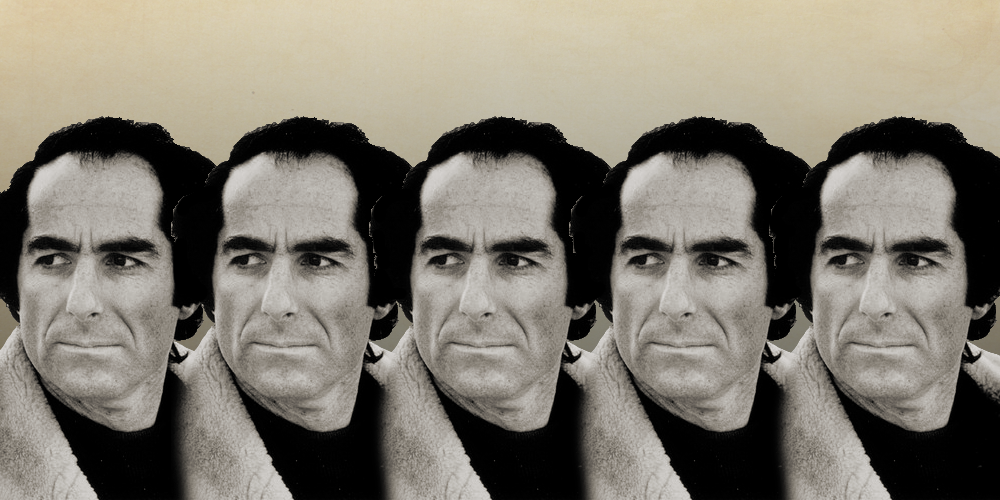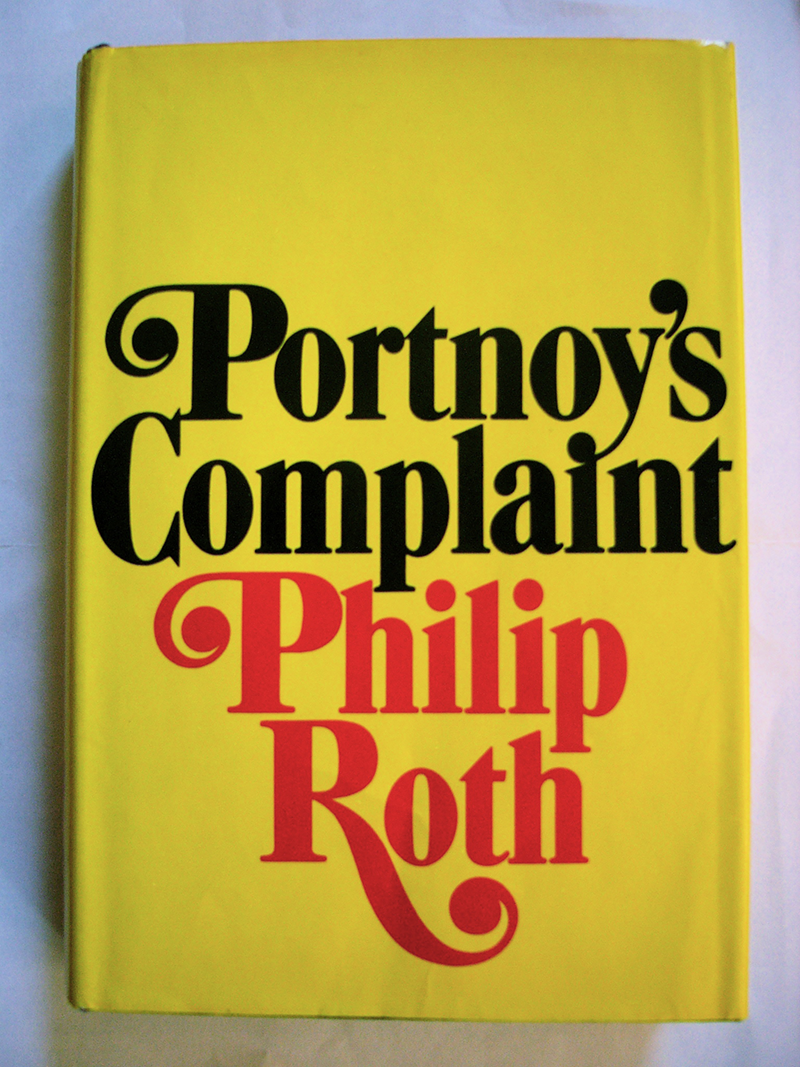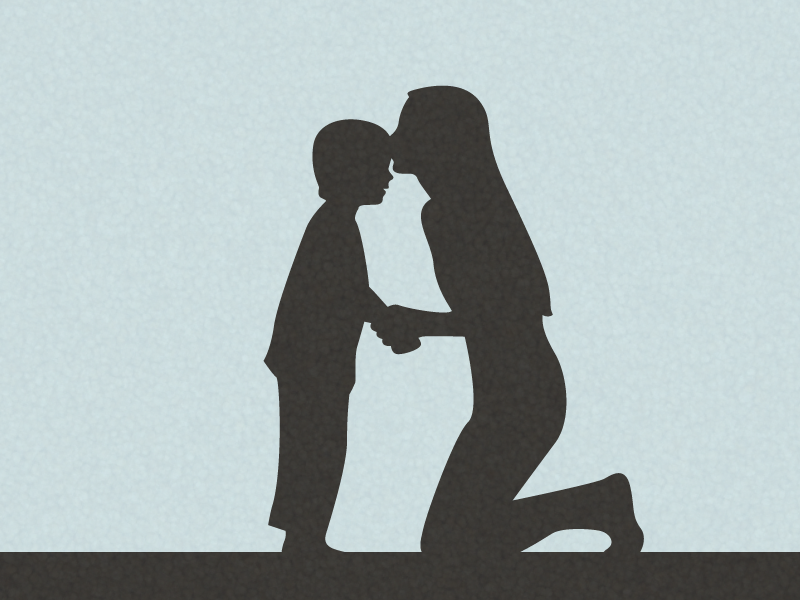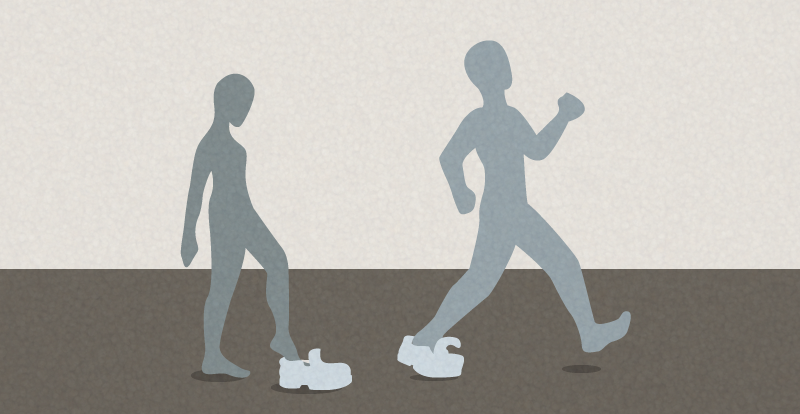Aside from getting intense about guitar solos, in my part of American culture it’s not manly to be too precise about beauty or goodness. There’s something peripheral and tiresome about a person who rattles on about all the ethical and aesthetic entanglements of the world — that’s what a bridezilla does, or a momzilla, or a punchline vegan. In Philip Roth’s books, not only is it acceptable for a person to be authoritative and also read a lot of fiction and care about what people are wearing, it’s the reason. A Roth character thinks everyone should fall in line behind him when he wants to talk to his friends about books and fight against oppression that’s the lifeblood of — more than democracy — the whole human experience. So I’ve been reading a lot of Philip Roth lately.
I started with Portnoy’s Complaint because “it’s all about masturbation!” either makes you want to read a book or avoid it. It could be shelved beside Lolita, in many respects — two mid-century sex books with propulsive first-person narrators — but below the surface, Roth is using a very different architecture. If you tried to write a version of Lolita from her perspective, you’d have to invent all the parts of her character that don’t directly connect to Humbert or the suffering he causes. Nabokov’s reader can’t ever see her mind working in a unique way that would set her apart from whatever girls lived in the houses on either side of the Haze residence, because it’s really Humbert’s book. Nabokov is most interested in a person who can essentially do what is in his character to do, not the person who’s stuck under his thumb. Lolita herself is just the place suffering happens.
Portnoy’s complaint is, essentially, that he’s the Lolita, but he’s not just a locus of suffering, he’s a person. His family and his entire life have been warped by the anti-Semitic prevailing culture that’s preventing him from being the person he should have been and prevented his mother and father from being the people they should have been. He’s not interested in assimilating. He wants his culture not to be rated lower than the other one. His complaint is that he’s stuck trying to become a whole person in the awkward and too-small negative space left by this other culture’s needs.
This interest in the negative space is unusual in Roth’s set: it’s not how John Updike, Saul Bellow, or Milan Kundera write. Power is the beginning of the story in these authors’ books. Nabokov isn’t interested in the effort and strategic thinking involved when a character navigates the struggle against someone powerful; his alphabet begins and ends with a man’s ability to assert himself unimpeded.
Portnoy’s Complaint adds a layer beyond the reverse — Lolita — Portnoy is also the Humbert. He blocks the light for his girlfriend, nicknamed “the Monkey.” The Monkey’s personality and struggles are entirely visible to the reader, even though Portnoy doesn’t have much sympathy for her. In fact, the book could be written from her point of view across all the same years without any more information than Roth gives, and The Monkey’s Complaint would be a book with very similar themes. There could be a complaint from the perspective of each of the secondary characters: Portnoy’s Mother’s Complaint, Portnoy’s Girlfriend’s Complaint, and Portnoy’s Father’s Complaint are all nested inside. Each of these people writhes around with specific injustices, trying to become themselves while constantly being thwarted. All these theoretical books are about people trying to build lives and identities in the negative space left by more powerful people.
Each scene in Roth’s earlier Goodbye Columbus advances the plot in one way at a time, each character is readable one way at a time, and the significance of an action is the same for the reader and for the other characters. The reader may fault a character’s priorities, but not his interpretation of what’s going on in each scene. Portnoy’s Complaint is a rain forest of motion and humidity by comparison (humidity = masturbation, in this case). Events are spread across many scenes with implication separate from action and from meaning. The meanings are different for different characters.
This is the narrative structure of the people who are out of power — meaning doesn’t come at the right time, actions are half complete and interrupted. The meanings are different for different characters as they work, grow, and build. Instead of attaching these almost-holy American values to the story of a man who gets and gives a fair shake at each stage between rags and riches, Roth writes the story of people who know they’re being played, who know they’re being kept down, and who keep trying anyway.
Roth virtually never writes about the kind of person who gets a fair shake, and the two groups that interest him most — Jewish men and white women of various backgrounds — are people trying to become people in the narrow psychological space left by the same group of men who have taken all the light and all the honors. He doesn’t write about the anti-Semitic boss, he writes about the boss’s wife and daughters and Portnoy’s desire for them. These are both groups of people trying to live around the margins of the same cowboys and good old boys.
Women who care about aesthetic and ethical meaning are the people Roth’s characters consider worth fighting for and fighting with. There are conventional tropes of priapism he avoids almost completely: the ideal woman being as little woman as possible — a nameless, hairless, air-freshened figure who shows up to give a few supportive blowjobs. He’s not writing about the series of notches on the bedpost: He’s interested in women for their varied conversation, dirty imaginations, big nipples, infidelity, and arguing styles.
He even writes about mothers — the rarest creature in literature, the mother of an adult man. Alex Portnoy wasn’t raised by a picnic and a bolt of lighting, he’s got a mother with a name and a personality. A mother is an undignified entanglement, and Roth writes like he knows something is going wrong in the life of a man who still believes he was shaped by his mom. He may enjoy writing about the company of women, but you can’t misunderstand a book like American Pastoral, even if Portnoy’s Complaint could be read multiple ways — the more serious Roth is, the more strenuously he argues for patriarchy. He wants his own patriarchy not to be rated lower than the patriarchy of the anti-Semitic bosses. He doesn’t think he personally should be in someone else’s negative space, but in American Pastoral he writes pretty unambiguously that the trouble of the world comes from women and children not being kept in line by their men, because that’s culture, and in culture there’s strength.
That’s a very stable and, I think, commonly held position, whether it’s acknowledged or not that any individual person’s strength comes from his or her culture. So it’s reasonable to fight for cultures to be rated as equal, to fight against racism, but that fighting against sexism means changing — attacking — those cultures.
I started reading Sabbath’s Theater after American Pastoral, and I think he draws a less simplistic moral world there, though it was written earlier. Mickey Sabbath lives outside of his culture, and outside of any culture’s conventions — he doesn’t have conventions to insulate himself from other people. Speaking his mind and doing things that would rightly repel others, Sabbath has more thrilling contact with the world. Not just sex with an unconventional variety of people, but the kind of sex that makes each person more sharply individual. It’s not only sex but a lot of it is sex, how different it is to be with different women as a metonym for all the ways people are unique and largely hidden from each other by the conventions and traditions that make people seem artificially similar.
For being so free, though, Sabbath has no insulation from the enormity of death. Those customs he rejects are the all-too-flimsy walls that would protect him from the force of how bad death is, how much is lost. He has no pieties to hide behind when he thinks of how disgusting and terrible it is to be buried under the ground and eaten by worms, or to lose that uniqueness of the people he has loved. He doesn’t have his traditions, he doesn’t have any way of thinking about it that makes it okay.
That’s the thing Roth is afraid of losing when he goes on to write a prim little book like American Pastoral. It’s not that he really believes women cause all the trouble of society with their willfulness when they’re badly disciplined, it’s that those same traditions that keep women in the men’s negative space are the only thing protecting him from his horror of death. He can let people step outside culture for an hour or two for the sake of having affairs, like Sabbath and his various girlfriends, but he can’t endorse people changing the culture itself.
I was watching the musical My Fair Lady on YouTube and thinking about how Henry Higgins sings that poor people could all just stop being poor en masse if they spoke like rich people. That’s absurd, of course. One or two flower sellers can change their futures by changing their accents, but as long as flowers need to be sold, nothing will change the poverty of flower sellers other than paying them more. That’s the deal Roth is willing to make in Sabbath’s Theater: that anyone can step outside of culture and convention for some erotic adventures and really spectacular fights, but most people had better step back in. We can’t really change things — we can’t pay the flower sellers more or let women be the heads of families or we’ll all be howling at the grave digger beside the chain link fence. That’s also an internally consistent and stable philosophical approach to many social problems and the thinking behind all kinds of American bootstrap-ism. One or two people of each demographic can get through once in a while, but the whole structure of society rests on most of the poor staying poor, most of the black people staying segregated, and most of the women staying subjugated in the various strands of American patriarchy.
In some ways, Roth wrote these books from a position that feels analogous to mine as a white woman. His Jewish identity had only recently stopped being such a liability that at one time would prevent a person like him from being taken seriously as a public figure, but he knows this could reverse at any time. He writes about people who live in a negative space, but he doesn’t have to struggle with it as much as his forefathers did. The struggle still feels personal, but it’s not so all-encompassing that he and his characters can’t all be famous authors. The big difference I feel as I keep reading is that most of the characters in his negative space know what they’re struggling to become — men. The aspirational maleness of a Roth character has no female counterpart.
We don’t really have an answer yet to this question — what is a woman? Is a woman the same kind of thing as a man, and if not, what are the differences? This isn’t a question any of the sciences or any of the arts have come up with a definitive answer for, and the hypotheses are constantly in flux. We know what men are, despite a few tweaks to definitions of masculinity across the world and over the years: a man is the basic unit of human endeavor. When black civil rights protesters hold signs that say “I am a man” — everyone knows what they’re claiming to be. A sign that says “I am a woman” would be more ambiguous. Sojourner Truth had to explain a lot in her “Ain’t I a Woman?” speech, and even then her definition was a work of self-creation, rather than placing herself a category that already had an integral dignity.
At the beginning of Janet Malcolm’s The Silent Woman, about Sylvia Plath and Ted Hughes, she writes about how she and another biographer, Anne Stevenson, are both close to Plath’s age and had similar experiences growing up, being directed toward becoming breezy, nice girls. The question of whether Plath was nice when she went over to lunch at Dido Merwin’s house, whether she was nice to the man who lived downstairs the night before she died, or to Ted Hughes, ever — those questions become ontological drills in Malcolm’s book, driving into the center of human experience. For many women of their generation, the question of niceness is deeply tied up with the questions of public existence, and existence at all. It doesn’t feel that way to me, though.
The things Malcolm says she and Stevenson have in common with Plath are things that I have in common with them also — I am from a similar kind of family and grew up just a few miles from where Plath was raised — but separate in time such that no one ever suggested that being nice was a serious goal for me or the girls around me. The qualities my mother praised in women we knew when I was a kid, the achievements that make my female friends proud, the qualities celebrated in the heroines of books I read, all those things aimed at being assertive rather than nice. Malcolm knows that there’s a unique way another woman raised in the era of niceness can understand Plath, and I love reading the result of that understanding, but it’s a great loss to my intellectual tradition that the short generational distance between us means the premises of our lives are so different. I don’t feel continuous with Plath, in part because we were told very different things about what kind of creature a woman is.
The shift from “if you can’t say something nice, don’t say anything at all” to “lean in” and the other reinventions white women have gone through in the 20th century are often described as progress for women’s rights, or even progress for women, but we’re all still being what a more powerful group of people need us to be. We’re still in one of Roth’s negative spaces. White women were Rosie the Riveter when society needed factory workers, and became Susie Homemaker when soldiers needed their factory jobs back. Over the same decades, men went from being workers to soldiers and back without any great changes in the definition of manhood, but each of the women’s changes included a shift in the universal and biologically determined shape of feminine nature. In one decade, a woman is naturally silly, in another she’s naturally a good student, but not very creative. In another, she’s creative but not good with numbers. She’s good with numbers but not abstractions. She can manage abstractions, but she can’t rotate shapes in her mind, not like a man.
The history of my people is the history of furiously scribbling “can you believe this shit?” about some absurd new belief about the absolute nature of woman that only applies to white women and has only been commonly accepted for as long as the latest hairstyle has been fashionable, but is still somehow everywhere and suffocating.
This is one reason our intellectual tradition is fragmented: It’s hard to keep the great classics of literature by women, and the very good but not great books can disappear because they’re in conversation with a conception of womanhood that’s been abandoned. Mary Elizabeth Braddon’s Lady Audley’s Secret is implicitly in conversation with the idea that a pretty girl with a china-doll face and laughter like bells can’t also be a psycho killer. Lady Audley’s secret is that yes, she can, and she’s planning to kill again. Since Braddon wrote though, we’ve moved on. Everyone knows pretty girls can be liars now.
A book like Great Expectations, written within the same time and place, is easy to interpret in the current day. There’s very little difference in English manhood between then and now. The only part that doesn’t update easily is Miss Havisham, because the meaning of a wealthy woman in her 30s with an adopted child is more different than the meaning of a criminal, the meaning of a working-class stepdad, the meaning of education or expectations. Les Liaisons Dangereuses is not by a woman, but it’s about women trying to make themselves into people in a context where a woman taking a lover and a man raping someone are equal crimes, both against the man who is in charge of the woman’s body, whether husband or father. Updated cinematically as Cruel Intentions, every character and action has a completely different significance. This kind of thing fractures our intellectual traditions, and with them, our continuity between generations.
We haven’t yet had an ontological shift in the meaning of womanhood that makes women regular ol’ people. A simple way to see how far women are from being considered neutrally human is how little it’s possible to understand black American womanhood by examining white American womanhood — there’s no logical connection between them. If you accept that the stereotypes of white women are some kind of evolutionary absolute about female people, the stereotypes of black women seem like they’re coming from another planet. Women are the weaker sex — except black women, but their strength is used to discredit them and leave them without support and care. There’s no logical connection between either of those groups and the things Asian-American women are typing “can you believe this shit?” about. Each negative space has its own dumb rules. We’re all in these little cubbies that go in and out of style, separated from one another and none of us considered neutrally human. As long as we’re not neutrally human, any advances in our rights or quality of life can be reversed in the course of a decade or two. It’s just a matter of adding some new stereotypes.
People in every subset of American womanhood and queerness are fighting to become whole against some set of logically scrambled bullshit stereotypes. It takes curiosity and courage to look beyond what you’re told is the inherent natural state of your being and see that your neighbors are told something very different about the inherent natural state of their beings, and none of them are “you are a whole person.” That practice is the essence of intersectional feminism.
Anti-racism is a matter of fighting to put one culture on par with another. One dining room table conversation is as good as another, and every man should get a fair shake. Intersectional feminism means changing the conversation at each dining room table, reaching into the unimaginably varied negative spaces all around the country and the world, and trying to understand what people — all genders, all people — experience in all those fragments of our broken traditions, and all our struggles for wholeness. It’s a much bigger job, and a more wonderful one, with more intellectual and moral grandeur than simply saying one form of patriarchy is as good as another. To the degree that we accept the challenge, intersectional feminism is the best thing we ever tried to do.
From Portnoy’s Complaint, I had a sense of a writer who might have looked at our most interesting ethical challenge and he might not have flinched. He had the curiosity and the narrative structures to write about the variety and complexity of negative spaces in which people struggle to build themselves. He might have wanted to metaphorically pay the flower sellers more rather than just changing Eliza Doolittle’s accent for a few sexy hours. He might have wanted to change his culture. That’s not the writer he turned out to be, because he looked at the prospect of changing culture and saw the abyss of death instead of freedom.
The Roth I’m reading is telling the story of our country’s failure. Portnoy’s Complaint, Sabbath’s Theater and American Pastoral together show why even progressive people aren’t united against sexism. Now we’re living in the book Roth flinched before writing — the one where misogyny is the door fascism walks in through. He wrote about the threat of attacks on traditional culture from the left, and the fear in a person without traditions, but he couldn’t write about white men — the white men that didn’t much interest him — radicalizing around their shared misogyny and calling it tradition.
That was how he spent the years while fascism was primarily overseas. He didn’t want to write about the anti-Semitic bosses and their sons, that part of American culture that thinks beauty and goodness are someone else’s problem. Roth didn’t write about the left hesitating before rallying against their evil because, in part, we’re not entirely sure what women are and if they can be trusted. He couldn’t predict that the last thing standing between our country and nihilism would be our collective ability to trust a female presidential candidate. He flinched before writing that our lingering willingness to leave women in their separate little negative-space ontological cubbies could be an infection of hatred that could flare up and might just kill us all. •
Feature image courtesy of Light show via Wikimedia Commons, and edited by Shannon Sands. First image courtesy of Matt & Megan via Flickr (Creative Commons). Other images by Shannon Sands.








